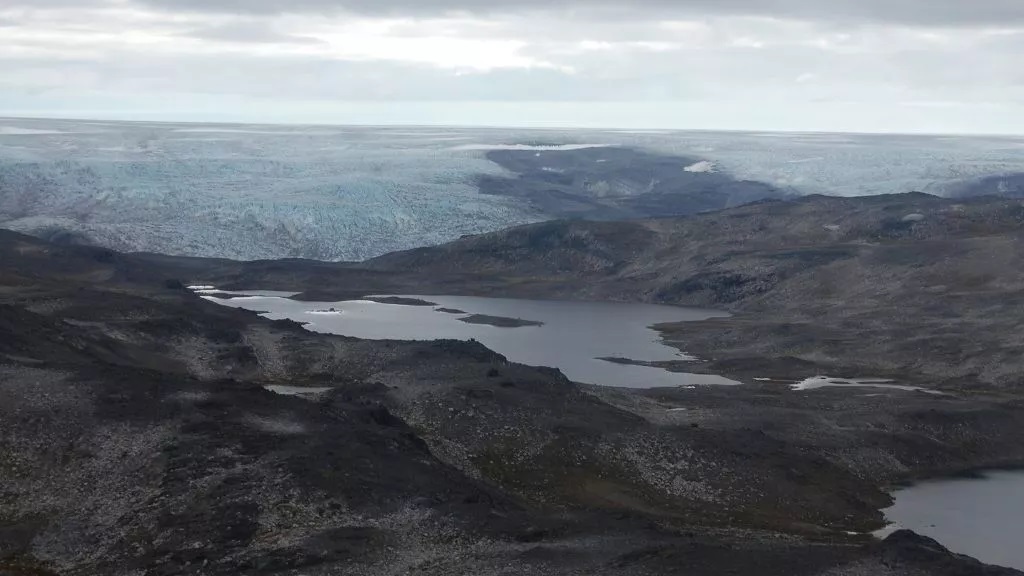
Rocks collected in Greenland may hold traces of an ancient magma ocean that bubbled over much of Earth’s surface soon after the planet’s birth, a new study finds.
Scientists gathered the rocks from the Isua supracrustal belt, a region in southwest Greenland where the exposed rocks are between 3.7 billion and 3.8 billion years old; the belt contains the oldest known rocks on Earth, which remain relatively undisturbed by plate tectonics, heat and chemical alterations, according to Science Magazine.
The chemical traces of the early magma oceans are even older than the rocks themselves, dating to roughly 4.5 billion years ago, when a Mars-size object slammed into Earth, knocking off a huge chunk of rock that later became the moon, according to the new study.
When celestial objects the size of Earth and Mars collide, “near-wholescale melting of the entire planet is an inevitable consequence of that,” lead author Helen Williams, a professor of geochemistry at the University of Cambridge, told Live Science. And as that molten rock cooled and crystallized, the Earth gradually came to resemble the blue marble we know today, she said.
But although most scientists accept the molten Earth theory, “a big challenge is that it’s very hard to find … geological evidence for something that happened so early on in our history,” Williams said. The new study, published March 12 in the journal Science Advances, shows that Isua belt rocks still bear chemical “fingerprints” left behind by this primordial cooling process.
Williams began hunting for these fingerprints after she and her co-author Hanika Rizo, an associate professor at the Carleton University in Canada, met at an American Geophysical Union (AGU) fall meeting, an annual event that in pre-pandemic times, drew tens of thousands of scientists from all over the world.
Rizo had previously extracted rock samples from the Isua supracrustal belt and wrote about them in a 2011 study, published in the journal Earth and Planetary Science Letters. In the paper, she noted that the rocks carried certain chemical signatures, namely unique isotopes, or chemical elements with varying numbers of neutrons. Williams later read the report, and these chemical signatures piqued her interest.
“Her paper doesn’t have direct geological evidence for the magma ocean in it. But so many of the chemical tracers that she discusses … really point in that general direction,” Williams said. If they studied the samples further, Williams thought, they may uncover a snapshot of Earth’s molten past. So when she spotted Rizo from across the expansive AGU conference hall, “I basically took off running towards her, because I really wanted to talk … about the possibility of collaborating,” Williams said.
To kick off their collaboration, the scientists headed to the lab. They selected a subset of volcanic rocks from the Isua samples, choosing only the most pristine, in terms of how much wear-and-tear they’d undergone after erupting to the surface and becoming exposed to the elements. They then sawed off the exposed surfaces of the rocks, sanded them down, crushed them into a fine powder and dissolved the powder in strong acids.
“By the time you’re done, it’s sort of incredible, that something that was a really hard, dense rock in your hand, is now actually a little vial of liquid in your laboratory,” Williams said. Processing the rocks in this way allowed the team to examine isotopes, or chemical elements with varying numbers of neutrons, within the samples.
Specifically, the team was looking for isotopes that would have formed as the magma oceans crystalized. Models suggest that some remnants of these crystals would have been trapped in the lower mantle, close to the Earth’s core, and preserved for billions of years. Through time, they would migrate through the lower mantle to the upper mantle, carrying the “isotope fingerprints” of the magma ocean with them, Williams said.
These fingerprints include hafnium and neodymium isotopes, which form when their parent isotopes decay; this breakdown occurs in a specific pattern when the parent isotopes are placed under extremely high pressures, like those found in the depths of the lower mantle, Williams said. The team found these unique isotopes in the Isua samples, along with a rare form of the element tungsten; known as a “tungsten anomaly,” these unusual tungsten isotopes stem from an ancient parent isotope that existed only in the first 45 million years of Earth’s history, Williams said.
As these crystal residues moved upward from the lower to upper mantle, they melted and mixed with other molten rock, creating a marbling effect. So once that mixed-up rock breached the crust, it carried the isotope fingerprints along with rock from both the upper and lower mantles; this was true of the Isua samples. There are several theories as to how and why the crystals migrated upward through Earth’s layers, one being that the crystals repeatedly melted and recrystallized, becoming more concentrated as they inched upward, Williams said.
After uncovering the chemical traces of magma oceans, “the question I have is whether other ancient rocks on Earth preserved the same signatures,” Williams said. She and her team are beginning to hunt for these signatures at sites across the globe, searching in locations with extremely ancient rocks and at modern hotspots for volcanic activity, such as Hawai’i and Iceland.
“Many lines of evidence … suggest that these modern hotspots are derived from melting of material really deep within the Earth, maybe even originating from close to the boundary between the Earth’s mantle and its core,” Williams said. That means that chemical traces of the magma ocean may also be lurking in these hotspots, though we don’t know that for sure yet, she said.
